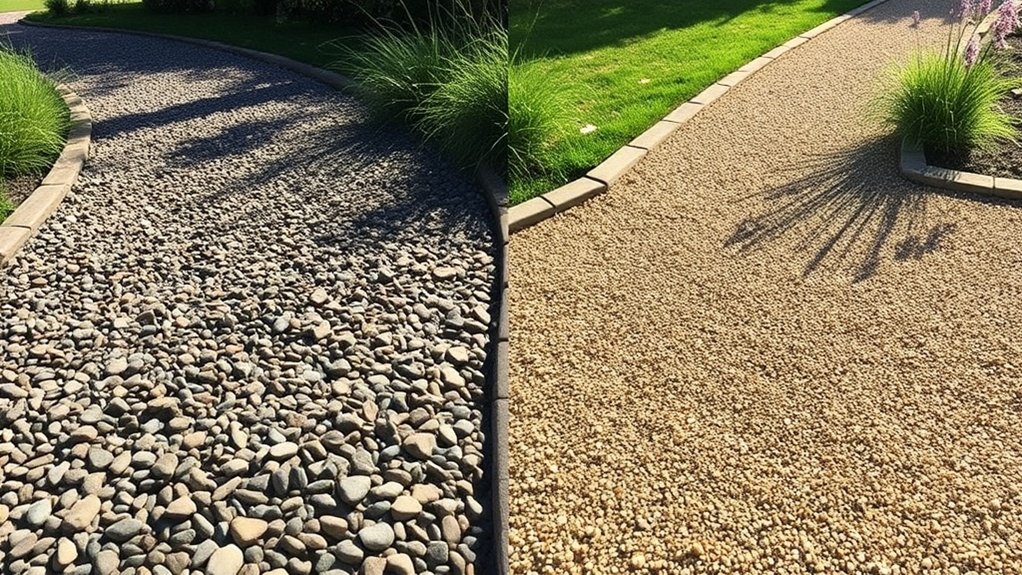No, resin-bonded gravel looks more natural than resin-bound gravel. The textured finish of resin-bonded surfaces resembles traditional loose gravel, giving an organic feel that fits well in rustic settings. On the other hand, resin-bound gravel has a smoother, more uniform appearance, making it suitable for modern designs. While resin-bonded gravel offers a natural aesthetic, the maintenance and durability of the two options differ significantly. It’s important to consider these factors when choosing the right surface for your project.
Key Takeaways
- Resin-bound gravel has a sleek and uniform look, giving it a modern feel rather than a natural appearance.
- In contrast, resin-bonded gravel has a rougher, textured finish that mimics traditional loose gravel, enhancing its natural look.
- The consistent colour and seamless design of resin-bound gravel may seem less organic compared to the varied textures found in resin-bonded gravel.
- Resin-bonded gravel can provide a more rustic aesthetic, making it ideal for historic or natural settings.
- Overall, resin-bonded gravel is generally seen as the more natural option due to its textured finish and closer resemblance to conventional gravel.
Texture and Finish Comparison
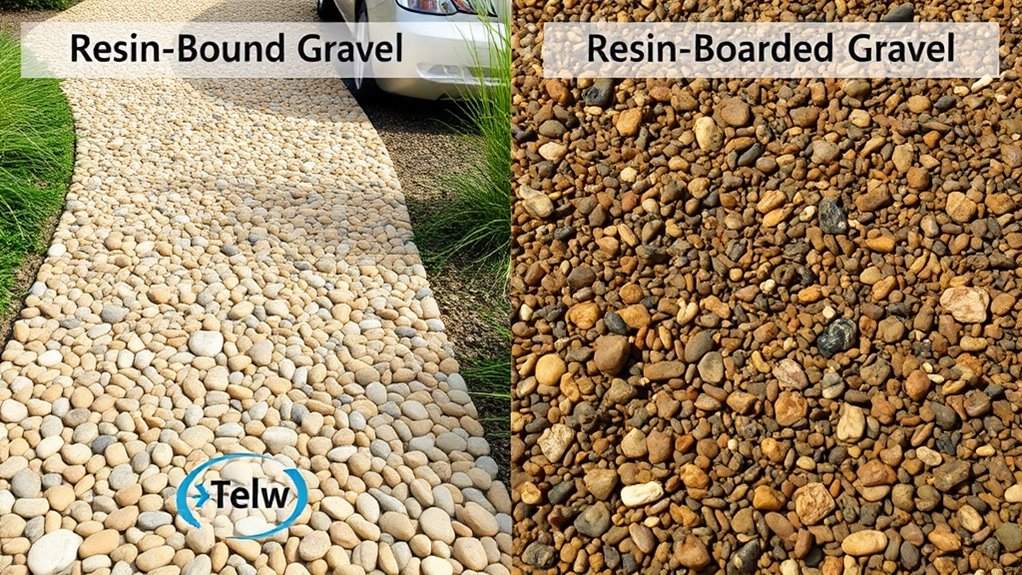
When comparing the texture and finish of resin-bound and resin-bonded gravel, it’s important to note their differences.
Resin-bound gravel provides a smooth, flat finish, making it durable and ideal for high-traffic areas. In contrast, resin-bonded gravel has a rougher, more natural appearance, which enhances grip, making it suitable for driveways. However, the seamless nature of resin-bound surfaces can reduce slip resistance when wet. Additionally, resin bound gravel allows excellent drainage, which helps in maintaining cleanliness and reducing puddling. The chemical bonds formed during the curing process contribute to the durability of resin-bound gravel surfaces.
In terms of maintenance, resin-bound gravel is easier to care for due to its porous nature, which allows for better drainage and cleanliness. On the other hand, resin-bonded surfaces require regular upkeep to prevent loose stones. Ultimately, your choice should reflect the balance between aesthetic appeal and practical performance.
Aggregate Distribution and Appearance
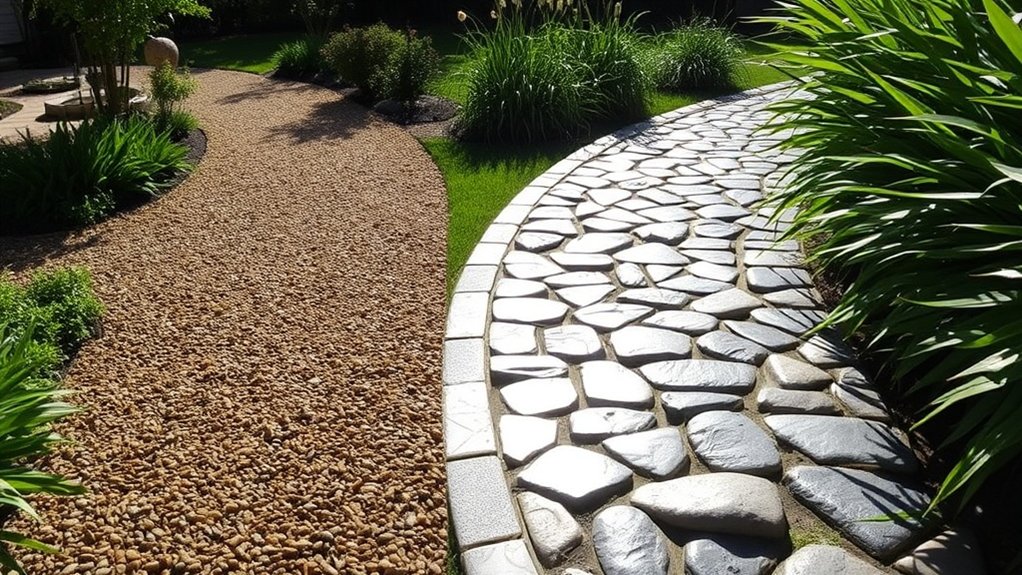
When examining aggregate distribution in resin-bound gravel, uniformity is essential for a smooth surface. This method coats each aggregate particle with resin, boosting both durability and appearance. In contrast, resin-bonded gravel creates a more textured surface, with varying aggregate distribution that can significantly influence the overall look. The high permeability of resin-bound systems also allows for better drainage, further enhancing their aesthetic appeal. Additionally, the use of eco-friendly materials in resin-bound driveways contributes to their sustainability and overall visual harmony with natural landscapes.
Uniform Aggregate Distribution
Uniform aggregate distribution plays a crucial role in both the aesthetic and functional qualities of resin-bound and resin-bonded gravel surfaces.
In resin-bound systems, aggregates are mixed thoroughly with resin before installation, creating a seamless surface where each stone is fully encased. This method ensures a uniform appearance with consistent colour and texture throughout the area. Additionally, the high permeability of resin-bound surfaces contributes to their ability to manage water drainage effectively, enhancing their overall functionality. The use of UV-stable resin further guarantees that the surface maintains its aesthetic appeal in various weather conditions.
On the other hand, resin-bonded systems involve scattering aggregate over a pre-applied resin layer. If the installation isn’t done carefully, you could end up with a patchy and uneven surface, which negatively affects the overall look.
The resin-bound system minimises visual inconsistencies, whereas the resin-bonded system, which relies on loose aggregate, can lead to variations that may compromise both appearance and functionality over time.
Textured Surface Differences
Both resin-bound and resin-bonded gravel surfaces have their own distinct textures that influence their look and practicality.
Resin-bonded gravel has a rough, loose texture, with visible aggregates that enhance its rustic charm. This texture provides excellent grip, making it a safer option in wet conditions.
On the other hand, resin-bound gravel offers a smooth, glossy finish, with aggregates fully embedded for a more uniform appearance that’s easier to maintain. The stones in resin-bound systems are less likely to move around, ensuring greater durability.
Ultimately, your choice will depend on whether you prefer a natural, textured look or a sleek, modern finish, along with considerations for safety and upkeep.
Color Consistency and Environmental Integration
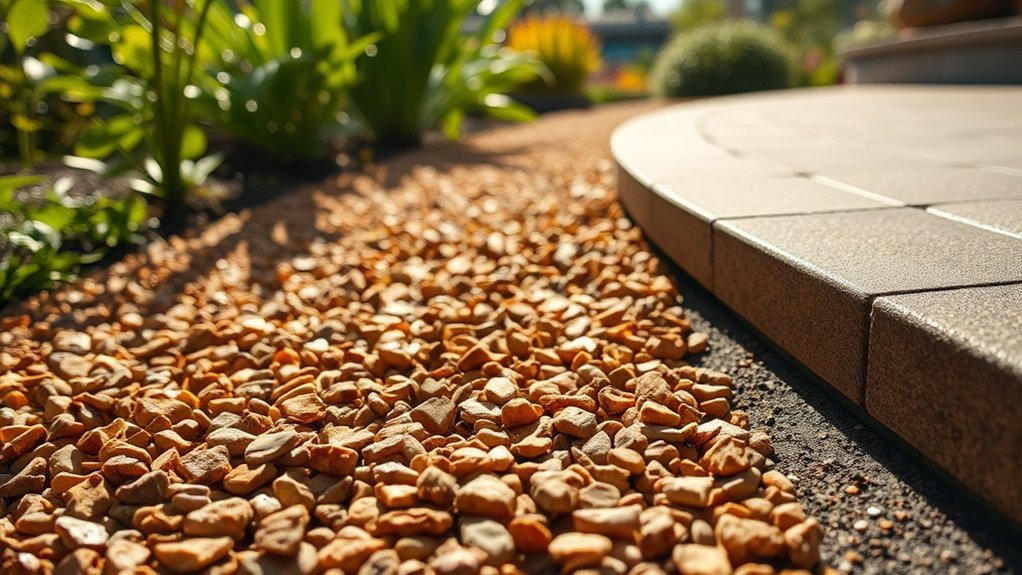
When it comes to colour consistency, resin bound gravel provides a uniform look thanks to its pre-mixed resin and aggregate. This creates a cohesive aesthetic for your space.
On the other hand, resin bonded gravel can appear more varied, which might impact how well it blends with the surrounding environment.
The design flexibility of resin bound surfaces also makes it easier to integrate into different landscapes, improving both functionality and visual appeal.
Uniform Color Distribution
Achieving consistent colour distribution is a key feature of resin-bound gravel. Made by blending aggregates with resin before application, this method ensures colour uniformity, enhancing the overall appeal of your space.
Here are three important points to consider:
- Seamless Integration: The smooth finish creates an even texture, preventing loose stones from affecting colour perception.
- Controlled Mixing: Using proper mixing ratios avoids surface clouding, ensuring a uniform look across the entire area.
- Versatile Options: A diverse range of coloured aggregates can be mixed, allowing for personalised designs that maintain consistent colour throughout.
Seamless Environmental Blending
Resin-bound gravel provides a uniform colour distribution and blends seamlessly with the environment, creating a natural connection with the landscape.
Its smooth surface integrates effortlessly, enhancing visual appeal while minimising disruption. Being fully permeable, it allows for groundwater replenishment and helps prevent water pooling and flooding, supporting ecological balance.
The use of natural aggregates in neutral and earthy tones ensures that the surface aligns with local soil and rock colours, maintaining visual consistency over time.
With minimal gaps for weeds, these surfaces promote a healthier ecosystem. Additionally, their durability and low maintenance requirements make resin-bound gravel a practical choice for sustainable landscaping in the UK.
Aesthetic Design Flexibility
Choosing resin-bound gravel offers a significant advantage for projects prioritising aesthetic design flexibility. This material ensures a consistent colour and a smooth finish, enhancing the overall look.
Here’s how resin-bound gravel stands out:
- Consistent Colour: The complete encapsulation of aggregates ensures a uniform appearance, reducing colour variation.
- Variety of Options: With a wide range of colours and aggregate types available, you can create innovative designs tailored to your project’s needs.
- Custom Patterns: Its precise mixing allows for intricate designs, making it more suitable for modern aesthetics compared to resin-bonded alternatives.
While resin-bonded gravel may blend well in traditional settings, its limited colour options can restrict your creative choices.
In contrast, resin-bound gravel offers the versatility needed for contemporary designs, making it an ideal choice for various environments.
Aesthetic Versatility in Design
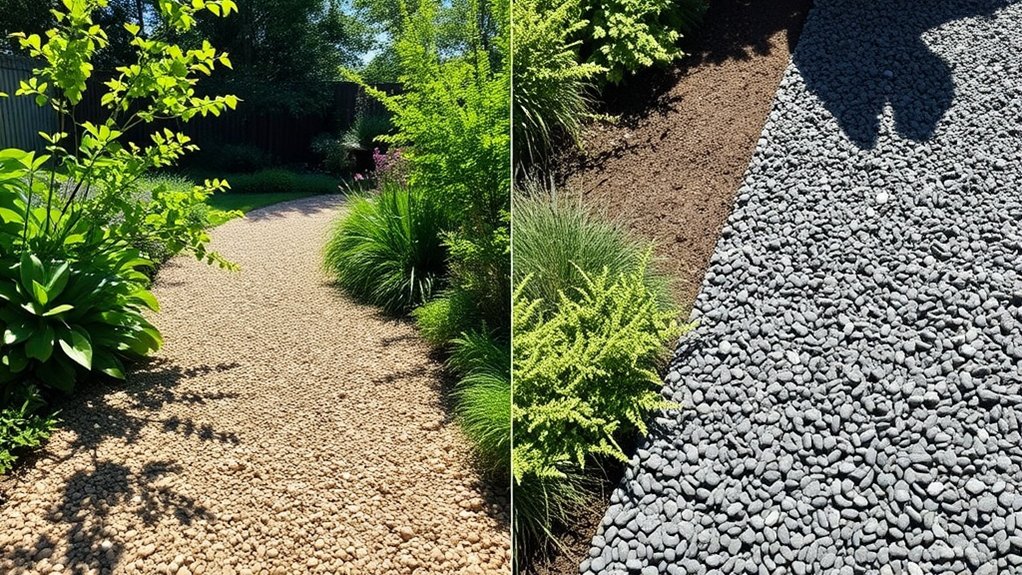
How do design preferences affect the choice between resin-bound and resin-bonded gravel?
Your selection is influenced by the natural look you want and how it fits with your overall design. Resin-bound gravel provides a smooth, uniform surface, making it ideal for modern designs that focus on clean lines and detailed patterns. It offers a range of colours and blends for tailored projects.
On the other hand, resin-bonded gravel has a textured finish, resembling traditional loose gravel, which suits rustic or historic environments. This option adds visual depth and an organic feel.
Both choices can enhance landscaping themes, but for a contemporary look, go for resin-bound. If you prefer a classic aesthetic, resin-bonded gravel is the better choice.
Durability and Maintenance Factors
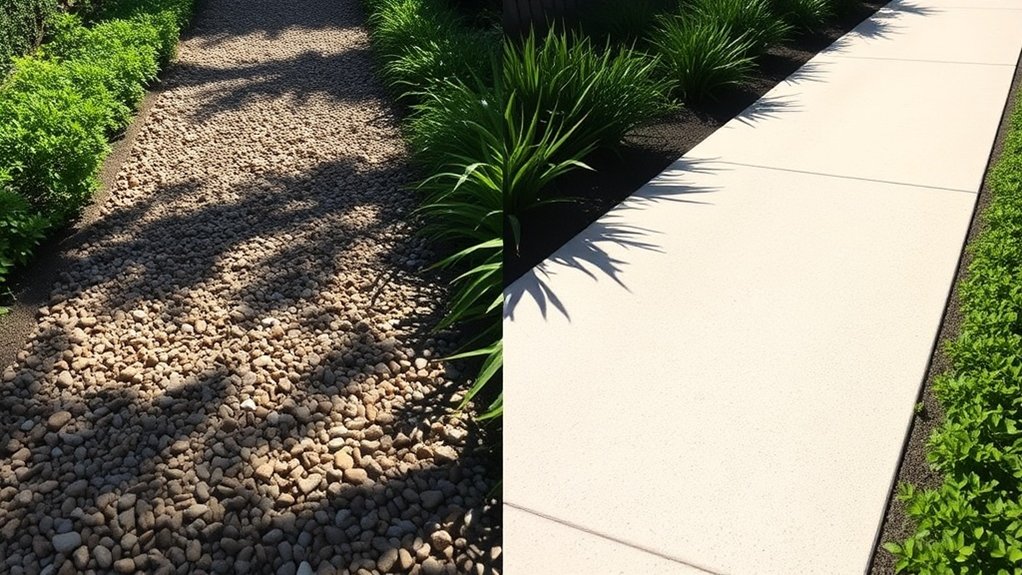
When comparing resin-bound and resin-bonded gravel, their durability and maintenance needs play a crucial role in determining their best uses. Here’s a straightforward comparison:
1. Durability & Longevity: Resin-bound surfaces can last over 25 years with minimal upkeep, as they form a sealed, crack-resistant layer.
On the other hand, resin-bonded surfaces tend to wear down faster, leading to loose stones and a decrease in durability over time.
2. Maintenance Requirements: Resin-bound options require very little maintenance, usually just the occasional sweep.
In contrast, resin-bonded surfaces need more frequent attention due to the loosening of the aggregate.
3. Surface Integrity: Resin-bound gravel has a smooth, encapsulated finish that makes it more resilient against wear and weather, unlike the textured resin-bonded surfaces that can be more susceptible to damage and displacement.
Permeability and Drainage Characteristics
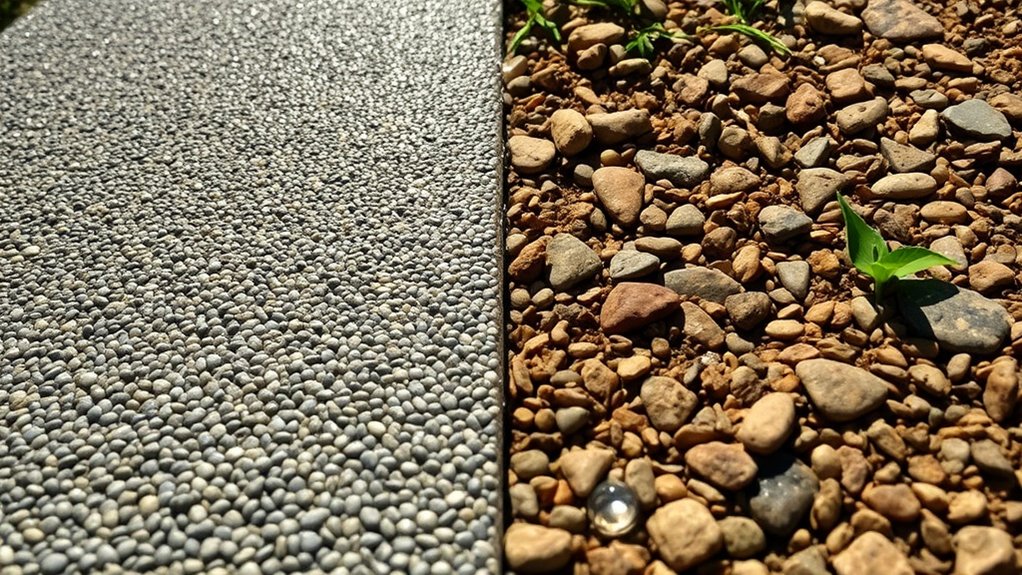
When it comes to permeability and drainage characteristics, resin-bound gravel is a top choice. Its design allows water to seep through effectively, enhancing drainage.
This is in contrast to resin-bonded gravel, which creates a sealed surface that prevents water from penetrating and increases surface runoff.
Using resin-bound gravel supports sustainable urban drainage systems (SUDS), which can help reduce local flooding and ease the burden on municipal drainage systems.
Its porous nature not only replenishes groundwater but also promotes tree health by allowing nutrients to reach root systems.
On the other hand, resin-bonded gravel isn’t suitable for flood-prone areas due to its tendency to exacerbate runoff.
Slip Resistance and Safety Considerations
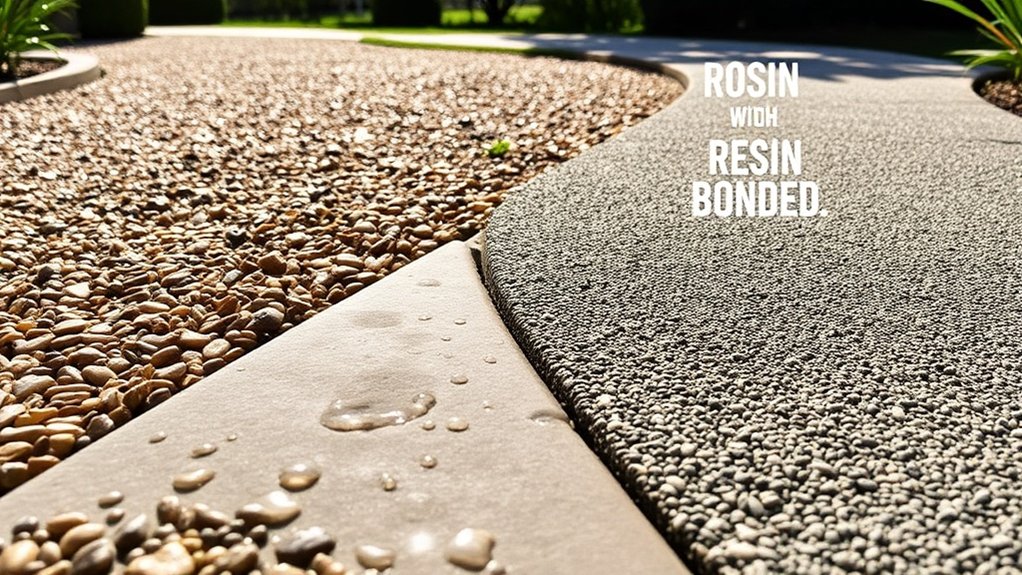
Understanding slip resistance and safety considerations is crucial when choosing between resin-bound and resin-bonded gravel surfaces. Here are the main points to consider:
- Surface Texture: Resin-bonded gravel has a rougher texture, which provides better grip. This makes it a suitable choice for driveways and ramps where slip resistance is vital.
- Weather Performance: Resin-bonded surfaces perform well in wet conditions, maintaining grip, whereas resin-bound options are frost-resistant and offer consistent safety in varying temperatures.
- Maintenance: Regular maintenance is essential for resin-bonded gravel to prevent loose stones.
In contrast, resin-bound gravel is less likely to develop algae, ensuring more stable slip resistance over time.
Cost and Installation Differences
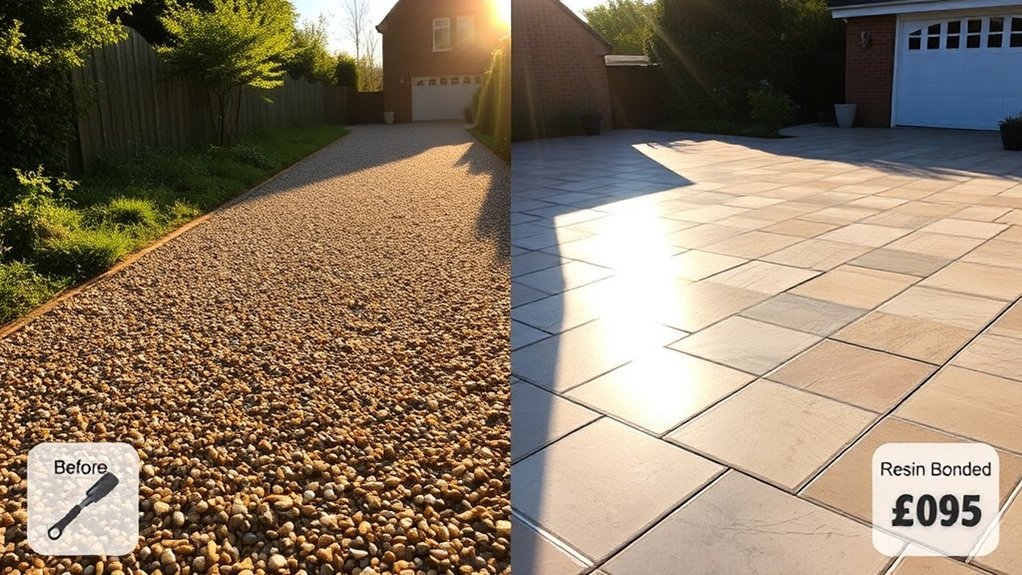
When deciding between resin-bound and resin-bonded gravel, it’s essential to consider both cost and installation differences.
Resin-bound gravel usually has higher initial costs due to its complex installation process. This involves mixing resin with aggregate for a smooth, seamless finish.
On the other hand, resin-bonded gravel is typically more affordable, as it simply requires applying a layer of resin over an existing surface and scattering aggregate on top. This method is quicker and less labour-intensive, leading to significant cost differences.
However, think about long-term durability: resin-bound gravel often lasts longer and requires less maintenance, which can make the higher upfront cost worthwhile.
Assess your budget and long-term requirements to make the best choice for your needs.
Frequently Asked Questions
How Do Weather Conditions Affect Resin-Bound Gravel Appearance?
Weather conditions, especially seasonal changes, significantly affect the appearance of resin-bound gravel. Rain and high humidity can interfere with the curing process, leading to uneven surfaces. Similarly, temperature fluctuations may cause cracking or deformation, which can undermine both the look and stability of the gravel. For example, if installed during a rainy spell, the finish might not set properly, resulting in an unsightly surface. It’s crucial to consider the weather before installation to ensure a durable and attractive outcome.
Can Resin-Bound Gravel Be Used for Steep Slopes?
Yes, resin-bound gravel can be used on steep slopes. To ensure both durability and stability, it’s important to follow proper installation techniques, manage drainage effectively, and use specialised aggregates that enhance grip and reduce erosion. For example, if you’re paving a sloped driveway, these measures can help prevent slipping and maintain the surface over time.
What Colors Are Available for Resin-Bound Gravel?
When considering resin-bound gravel, you’ll find an array of vibrant colour options. From striking reds to gentle earth tones, these choices not only enhance the visual appeal but also allow you to create a distinctive surface that stands out. For example, a bold red can make a driveway pop, while a subtle grey might blend seamlessly with a modern home.
Is Resin-Bound Gravel Eco-Friendly?
Yes, resin-bound gravel is eco-friendly. It helps reduce environmental impact thanks to its high permeability, which allows water to drain through easily, reducing surface run-off. Additionally, it can be made from recyclable materials and requires minimal maintenance. This promotes better urban water management and helps maintain soil health effectively.
How Does Resin-Bound Gravel Impact Property Value?
Resin-bound gravel significantly enhances property appeal, often increasing resale value by 5-20%. Its attractive finish, durability, and low maintenance requirements draw in buyers, making your property more appealing and potentially leading to faster sales. For example, a driveway finished with resin-bound gravel can make a home look more polished and well-kept, which is often a deciding factor for prospective buyers.
Conclusion
When choosing between resin-bound and resin-bonded gravel for your outdoor space, it’s important to consider their appearances. Resin-bound gravel tends to have a more natural look, while resin-bonded gravel offers a sleek, uniform finish. For instance, if you’re aiming for a rustic garden pathway, resin-bound might be the better option. On the other hand, if you’re looking for a modern driveway, resin-bonded could be a great choice. Ultimately, your decision should reflect your personal style and the overall aesthetic of your property. Remember, what looks good to one person may not to another, so choose what resonates with you.
